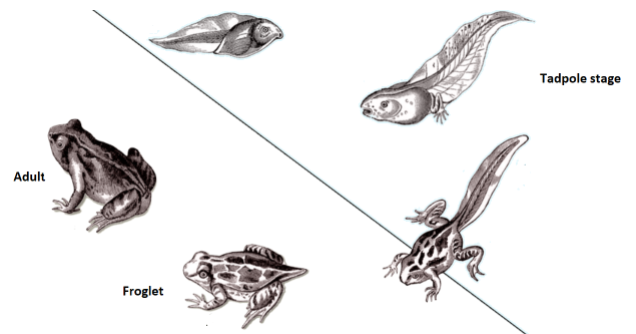
What does the metamorphosis of a frog involve?
Answer
434.1k+ views
Hint: Frogs are amphibians, which means they spend half of their lives in the ocean and the remainder of their lives on land. Frog metamorphosis is the transition of a fish-like creature with gills and a tail into a semi-aquatic frog. The transition of a frog from a fish-like shape to an adult frog is known as metamorphosis.
Complete answer:
Metamorphosis is a developmental phenomenon in which species, such as butterflies, amphibians, and a few marine animals, experience drastic physical changes shortly after birth. Metamorphosis is a mechanism that replaces an organism's whole body.
Frogs begin life as eggs that hatch into tadpoles. The tadpole starts swimming and feeding on algae after a week or more. Tadpoles consume plants and digest algae with a long, coiled intestine. They swim in a fish-like manner, with undulating body movements and a tail. Tadpoles have external gills as breathing organs.
Tadpoles lose their gills about four weeks and rely on their lungs to breathe. The hind limbs emerge at six to nine weeks, followed by the forelimbs. The organism may begin to consume insects and other plant matter, and the length of the intestine may shorten. The tail shortens over time, gradually being nothing more than a stub about twelve weeks, and then vanishing completely.

Note:
- Metamorphism is the product of hormonal changes.
- The maturation of enzymes and blood cells, as well as the remodeling of the nervous and digestive systems, are examples of these improvements.
- The hormone thyroxine, which is released by the thyroid gland, regulates metamorphosis in frogs.
Complete answer:
Metamorphosis is a developmental phenomenon in which species, such as butterflies, amphibians, and a few marine animals, experience drastic physical changes shortly after birth. Metamorphosis is a mechanism that replaces an organism's whole body.
Frogs begin life as eggs that hatch into tadpoles. The tadpole starts swimming and feeding on algae after a week or more. Tadpoles consume plants and digest algae with a long, coiled intestine. They swim in a fish-like manner, with undulating body movements and a tail. Tadpoles have external gills as breathing organs.
Tadpoles lose their gills about four weeks and rely on their lungs to breathe. The hind limbs emerge at six to nine weeks, followed by the forelimbs. The organism may begin to consume insects and other plant matter, and the length of the intestine may shorten. The tail shortens over time, gradually being nothing more than a stub about twelve weeks, and then vanishing completely.

Note:
- Metamorphism is the product of hormonal changes.
- The maturation of enzymes and blood cells, as well as the remodeling of the nervous and digestive systems, are examples of these improvements.
- The hormone thyroxine, which is released by the thyroid gland, regulates metamorphosis in frogs.
Latest Vedantu courses for you
Grade 10 | CBSE | SCHOOL | English
Vedantu 10 CBSE Pro Course - (2025-26)
School Full course for CBSE students
₹37,300 per year
Recently Updated Pages
Master Class 11 Economics: Engaging Questions & Answers for Success

Master Class 11 Business Studies: Engaging Questions & Answers for Success

Master Class 11 Accountancy: Engaging Questions & Answers for Success

Master Class 11 English: Engaging Questions & Answers for Success

Master Class 11 Computer Science: Engaging Questions & Answers for Success

Master Class 11 Maths: Engaging Questions & Answers for Success

Trending doubts
State and prove Bernoullis theorem class 11 physics CBSE

1 ton equals to A 100 kg B 1000 kg C 10 kg D 10000 class 11 physics CBSE

State the laws of reflection of light

One Metric ton is equal to kg A 10000 B 1000 C 100 class 11 physics CBSE

Difference Between Prokaryotic Cells and Eukaryotic Cells

1 Quintal is equal to a 110 kg b 10 kg c 100kg d 1000 class 11 physics CBSE




